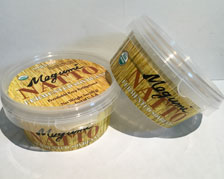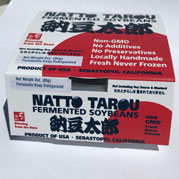Products
Ingredients: Soybeans (American grown) and Bacillus Natto
Non GMO Ingredients • No MSG added • Perishable - keep refrigerated • Locally hand-made

Megumi NATTO
Certified Organic by QAI
Non-GMO large soy beans
3 oz (85g) plastic cup
with tamper evidence seal
No sauce and spice packet

Natto TAROU
Non-GMO small beans (not organic)
3 oz (85g) plastic cup
No sauce and spice packet
Discontinued.
Preparing and Eating NATTO
- 1. Open NATTO and peel off the plastic film. To cut the natto strings use some for stirring and wind around your utensil quickly. Do not stretch. Good natto strings may stretch up to four feet.
- 2. Put NATTO in slightly bigger and deeper bowl (if needed) and stir beans 15-20 times.
- For Tezukuri NATTO
- 3. When you begin to see the characteristic sticky threads of natto emerge, add a packet of soy sauce and a little mustard.
- 4. Stir again this mixture then you are ready to enjoy your NATTO.
- For Megumi NATTO
- Instead of Soy sauce and mustard, you can create your own NATTO simply by selecting Sauce and Topping, Stir them with NATTO. And serve on your favorite Base.
Please look at MegumiNATTO Simple Recipes
Japanese-style BreakfastAfter adding soy sauce or mustard, as described the above, people in Japan often add a garnish of chopped green onions and eat the natto on top of some piping hot rice. The Japanese diet is known to lack protein, which natto supplements, and the onion adds Vitamin C – a natural "wisdom of life" reflected in the food culture of Japan. Many people love to eat natto made in this simple and delicious way. You may also follow the popular Megumi NATTO recipe below. |
Make Friends with Natto’s Sticky Strings!Natto’s essential stickiness comes from its beneficial amino acid, glutamic acid. After you have eaten natto, you can easily remove any remaining traces of it from your dishes or utensils by simply soaking them in cold or hot water for 10 minutes. People say that these sticky strings are what promotes healthy and beautiful skin. You may notice that your skin feels silky smooth after washing natto from your hands. |
The shelf life of NATTO
Because NATTO is a fermented food product, it is difficult to answer questions regarding shelf life. It is suggested that imported frozen natto be consumed within a week after defrosting, but based upon our experience of manufacturing and selling fresh NATTO in the United States for two years, and in order to consume at its peak flavor, we suggest that you eat the Tezukuri NATTO within four weeks and the organic Megumi NATTO within six weeks.
Both can be eaten past these suggested dates, but fermentation will continue and the flavor and smell will become stronger.
Also, as the NATTO ages, white specks will form—these are amino acid crystals that have formed on the beans, and are completely safe to eat. They have a certain crunch to it, so if that is not something you enjoy, you may want to consume the NATTO before that occurs.
NATTO can be frozen – please do so during its shelf life, and determine the timing by the level of fermentation you prefer. Please thaw in your refrigerator and consume immediately after thawing. The flavor of defrosted natto will be inferior to fresh NATTO.
(Note): Because fermentation levels will vary depending upon conditions under which the natto is maintained during distribution and storage, the above time frames are rough estimates.
Only one product may be purchased per order from the website, but you may place multiple orders. For ordering Bulk package, please contact us for availability.
* We ship only on Monday through Wednesday.
